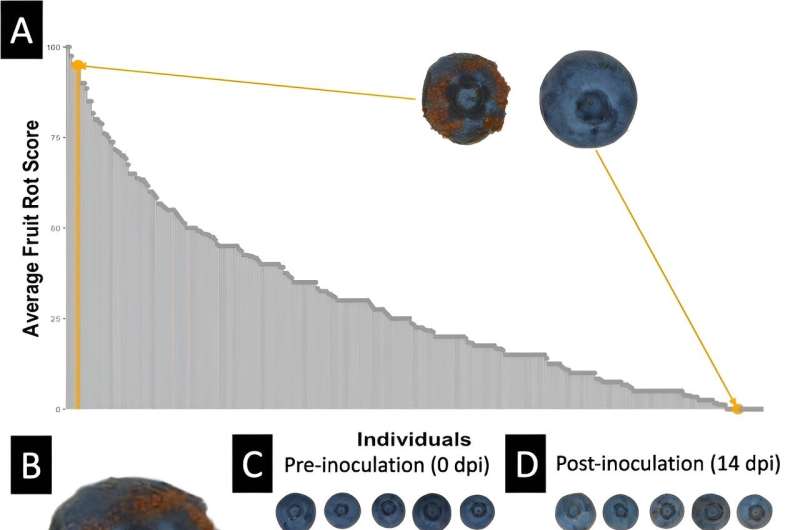This article has been reviewed according to Science X's editorial process and policies. Editors have highlighted the following attributes while ensuring the content's credibility:
fact-checked
proofread
Uncovering genetic metabolite markers associated with anthracnose resistance to blueberry fruit rot

Anthracnose fruit rot (AFR), caused by the fungal pathogen Colletotrichum fioriniae, is the most destructive and widespread fruit disease of blueberry, impacting fruit quality and yield. The reliance on fungicides prompts the need for sustainable solutions, highlighting the importance of breeding AFR-resistant cultivars. Research points to quercetin glycosides in blueberries with potential antifungal properties against AFR, yet the genetic and biochemical underpinnings of resistance are poorly understood. This knowledge gap underscores the urgency to explore the genetic basis and phytochemical defenses against AFR to develop environmentally friendly, resistant blueberry varieties.
In August 2023, Horticulture Research published a study titled "Uncovering genetic and metabolite markers associated with resistance against anthracnose fruit rot in northern highbush blueberry."
The research team employed association mapping, revealing three quantitative trait loci (QTLs) linked to AFR resistance. Candidate genes within these genomic regions were associated with the biosynthesis of flavonoids (e.g. anthocyanins) and resistance against pathogens. Specifically, the SNP on chromosome 17 at position 22 625 275 lies in a candidate regulatory locus 1.8 Kilo bases (Kb) upstream of a poorly characterized protein with a moderate 34% similarity to the Arabidopsis cytokine signaling protein AT4G33800.
Another SNP on chromosome 23 was located near a YABBY family transcription factor AT2G26580 (Yab5), potentially influencing phenylalanine ammonia-lyase (PAL) activity, critical for flavonoid biosynthesis. The SNP on Chromosome 28 was associated with the Arabidopsis gene GGL17 (AT3G11210), an SGNH hydrolase-type esterase, implicated in anthocyanin metabolic processes.
Furthermore, the team examined gene expression changes in fruits following C. fioriniae inoculation and revealed an enrichment of genes associated with certain specialized metabolic pathways (e.g. flavonol biosynthesis) and pathogen resistance. Non-targeted metabolite profiling identified a flavonol glycoside, consistent with quercetin rhamnoside, significantly more abundant in resistant individuals. This compound's role in AFR resistance was supported by its higher concentration in resistant lines, although variability within groups suggested a complex resistance mechanism not solely reliant on this compound.
Overall, this study provides valuable insights into the genetic and biochemical underpinnings of AFR resistance in blueberries, highlighting specific genomic regions, candidate genes, and metabolites that could facilitate the breeding of resistant cultivars, enhancing blueberry production sustainability.
More information: MacKenzie Jacobs et al, Uncovering genetic and metabolite markers associated with resistance against anthracnose fruit rot in northern highbush blueberry, Horticulture Research (2023). DOI: 10.1093/hr/uhad169
Provided by BioDesign Research




















